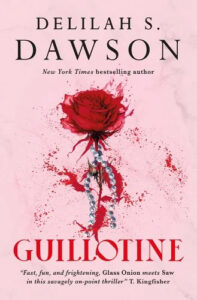First of all, I’d like to go on record as stating that I have never killed—or tried to kill!—anyone*. Even those who deserved it.
Secondly, I still fantasize about it all the time.
Even this morning, when a woman in a large brown SUV cut me off and drove dramatically slowly in front of me while holding up her phone to her mouth and shouting into it? I definitely imagined just slamming into her sideways like the bus that hit Regina George. Did I do it? No. And I think that’s admirable. Because I have self-control.
As a writer of horror and thrillers, revenge sits heavily on my mind. My career currently centers around creative ways to kill my imaginary friends, especially in my latest book, Guillotine, in which scrappy fashion student Dez Lane is determined to do anything to get her foot in the door at Nouveau magazine, even date the sexist son of the editor, Marlene Caulfield-Ruskin. Dez plays nice to get on the Ruskins’ private island, but then all hell breaks loose as the servants seek revenge for generations of abuse. I had so much fun murdering all those people who deserved it—because haven’t we all held a croquet mallet and wondered if it would be bouncy when striking a human skull? If you’re angry at billionaires, Guillotine might be the book for you. I was recently asked in an interview if it was traumatic to write, and the answer is:
No. It was cathartic.
And we all crave catharsis.
Modern media abounds with such stories of gory redemption. As a society that depends on courtesy and patience to avoid bludgeoning each other to death in the Target line, we love rooting for a protagonist who takes matters into their own hands in a way we cannot. We admire a vigilante, an underdog, a person who is so confident, certain, and efficient in their brutality that they’re not worried about the legalities or repercussions of their actions. Above all, we adore watching a villain get what they deserve. This isn’t a Mary Sue, this is a Carrie Sue, and every one of us has wished to stand triumphant, covered in blood, as our enemies realize—too late— that they have messed with the wrong person.
My earliest memory of delicious revenge was watching 9 to 5 with Dolly Parton, Lily Tomlin, and Jane Fonda. I loved the whimsy of their murderous daydreams, the fact that the three women bonded together instead of becoming enemies, and the way that the story ended correctly: happy endings for them, while their misogynistic, lying boss was eaten by cannibals.
As I grew up, vicarious revenge planted itself in my brain. I saw Sebastian chase down his bullies in The Neverending Story, gawked as Carrie set fire to her tormentors at prom, celebrated as Bigwig bested General Woundwort, cried as Aslan took down the White Witch, and ground my teeth to stumps as Katniss went after President Snow. Whether on the page or on the screen, I can’t wait for that moment in the story where the tides turn and I wear a feral grin, teeth bared as someone’s uppance has come. In real life, I am quiet and introverted and will apologize for existing. On the page and when consuming media, I am beating my chest like a gorilla, hungry for blood.
Some revenge stories stand out in my memory for the sheer audacity. Quentin Tarantino’s uniquely stylish violence in the Kill Bill movies, for example. Putting the audience in a coffin alongside the heroine as she punches her way through an inch of wood and six feet of dirt, driven solely by revenge—that was a power move. When I read Gone Girl by Gillian Flynn, I absolutely did not expect what happened after Amy’s perspective shifted. That scene? With Desi? In bed? Wow. I love any story that can surprise and delight me, especially with a box cutter. And then we get to Jennifer’s Body, a movie in which the opening line is “Hell is a teenage girl”. In this campy horror story, the villain is actually the vehicle for revenge, a possessed girl whose monstrous appetites cause her to hunt, seduce, and devour the guys who have wronged her—and one perfectly nice emo boy who probably didn’t deserve it. I do not personally wish to vomit black bile and eat the captain of the football team, but I can name the guys from my high school I would’ve added to Jennifer’s snack list.
More recently, I’ve enjoyed seeing revenge on the Horror shelves. In The Only Good Indians by Stephen Graham Jones, the spirit of a dead mother elk rains down terror and insanity on four friends who wrongly killed her. In Tiny Threads by Lilliam Rivera, a young Cuban-American woman nabs her dream job at a fashion house in a California town with a blood-soaked past, only to find herself tangled in trauma and self-medication with booze. Her dream becomes a nightmare when the past won’t stay dead and her boyfriend reveals his true face—and the reason revenge is required to heal old wounds.
And I actually have *another* horror book centered on revenge publishing this fall. It Will Only Hurt for a Moment is an atmospheric, gothic thriller about Sarah Carpenter, who has just left an abusive relationship to join an artists’ retreat in the north Georgia mountains and reconnect with her love of ceramics. But when she finds a coffin while digging a pit kiln, she awakens someone who needs revenge… and they have more in common than Sarah expects.
As I look at my backlist, I must confront revenge as a running theme in my work. All my life, I’ve been encouraged to be quiet, behave, make nice, and turn the other cheek. And I have. But deep inside, there is a part of me that resents that, and she daydreams about punishing those who have harmed her. I can’t even complain about the temperature of my steak, so I will write my books that paint the world red with gore.
And you know what? It feels good.
If revenge is good enough for Dolly, it’s good enough for me.
* This is partially untrue. I just killed two mealworms before putting them in the enclosures of my pet tarantulas. Not for fun, but because the little freaks can burrow into the substrate and then attack my poor, innocent spiders. Die, mealworms, die!
***


















